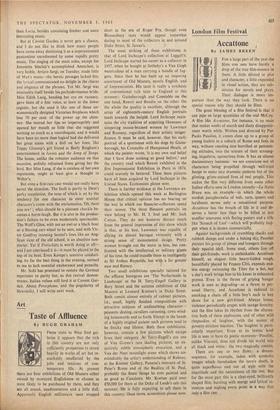Art
Taste of Affluence
By HUGH GRAHAM
short in the era of Roger Fry, though even Bloomsbury taste would appear somewhat daring to most of the collectors in and around Duke Street, St. James's.
The most striking of these exhibitions is that of Lord lnchcape's collection at Leggatt's. Lord Inchcape started his career as a collector in 1957, when he bought at Sotheby's a Van Gogh watercolour of a man carrying a bundle of fag- gots. Since then he has built up an imposing assortment of Old Masters, mostly English. and of Impressionists. His taste is really a synthesis of conventional rich taste in England at this moment : Gaihsborough and Constable on the one hand, Renoir and Boudin on the other. On the whole the quality is excellent, although the array of eighteenth-century English portraits tends towards the insipid. Lord Inchcape main- tains the city tradition of acquiring likenesses of simpering mouse-brained women by Lawrence and Romney, regardless of their artistic insigni- ficance. It must be said, however, that his early portrait of a sportsman with his dogs by Gains- borough, his Constable of Hampstead Heath, of which the painter wrote, it is my own real belief that I have done nothing so good before,' and the country road which Renoir exhibited in the first Impressionist Exhibition in Paris in 1874, could scarcely be bettered. These three pictures have all been acquired by Lord Inchcape in the United States. Economists please note.
There is further evidence at the Lawrence ex- hibition which opened this week at Burlington House that critical opinion has no bearing on the way in which our financier-collectors spend their money. The three flimsiest portraits on view belong to Mr. H. J. Joel and Mr. Jack Cotton. They do not however detract much from the general impression of this show which is that, at his best, Lawrence was capable of allying an almost baroque virtuosity with a strong sense of monumental design. Pretty women brought out the worst in him, but con- fronted with the intellectual or military giants of his time, he could transfix them as intelligently as Sir Joshua Reynolds, but with a far greater ease and fluency.
Two small exhibitions specially tailored for the affluent bourgeois are 'The Netherlands in Landscape' at the H. Terry-Engell Gallery in Bury Street and the autumn exhibition of Old Masters at Leonard Koetser's in Duke Street. Both consist almost entirely of cabinet pictures, i.e., small, highly finished compositions with attractive subjects of undisturbing character— peasants skating, cavaliers carousing, cows wind- ing homewards and so forth. Except in the hands of a highly original painter such pictures tend to be finicky and lifeless. Both these exhibitions, however, contain a few pictures which escape from their category. At Terry-Engell's are one of Van Goyen's rare skating pictures, an ex- quisitely subtle atmospheric evocation, and a Van der Neer moonlight scene which shows un- mistakably the artist's understanding of Rubens; at the Koetser Gallery, Pannini's interiors of St.
Peter's Rome and of the Basilica of St. Paul, probably the finest things he ever painted and as good as Canaletto. Mr. Koetser paid over £50,000 for them at the Duke of Leeds's sale this summer. He is fully expecting to sell them in this country. Once more, economists please note.














































 Previous page
Previous page